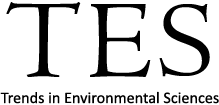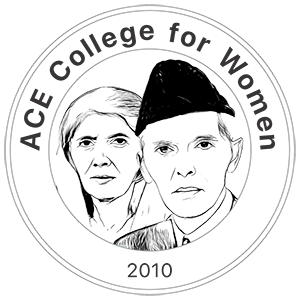Antifungal Potential of Cyanobacterium Anabaena sphaerica as a Biocontrol Agent Against Phytopathogenic Fungi
| Received 27 May, 2025 |
Accepted 02 Jul, 2025 |
Published 30 Sep, 2025 |
Background and Objective: Because of their versatility across various industrial sectors, cyanobacteria are attracting a lot of attention and are a rich source of secondary metabolites. Some of these compounds have an established history for avoiding the growth of fungi. The antifungal activities of the cyanobacterium Anabaena sphaerica.This study evaluates the antifungal potential of the cyanobacterium Anabaena sphaerica as a biological control agent against phytopathogenic fungi. Materials and Methods: Phytochemicals of Anabaena sphaerica were extracted with water, methanol, ethanol, acetone, and petroleum ether. Antifungal activity was performed against four pathogenic fungi (Fusarium oxysporum, Alternaria alternata, Aspergillus flavus and Rhizopus stolonifera) following the disk diffusion method. Results: The presence of phytochemicals flavonoids, terpenoids, phytosterol, alkaloids, amino acids, glycosides, diterpenes, saponins, and sugars were the that were identified in the tested extracts. Based on the measured inhibitory zone widths, the investigated extracts of cyanobacteria Anabaena sphaerica demonstrated a high level of fungicide ability. The findings indicated that Anabaena sphaerica extracts exhibited notable antifungal activity. Conclusion: The cyanobacterium Anabaena sphaerica may be recognized as a possible source of bioactive substances that requires more investigation.
| Copyright © 2025 Elaziz et al. This is an open-access article distributed under the Creative Commons Attribution License, which permits unrestricted use, distribution, and reproduction in any medium, provided the original work is properly cited. |
INTRODUCTION
It has been demonstrated in recent years that chemicals made by Cyanobacteria may be effective substitutes for antibiotics in the fight against different medications1. Gram-negative cyanobacteria are thought to be 3.5 billion years old2,3 and the earliest creatures on Earth to perform oxygenic photosynthesis. These organisms are also more productive than other natural creatures because of their quick growth and adaptability to different environmental circumstances. Compounds generated from microalgae and cyanobacteria are preferable to other natural antimicrobial sources because of these qualities, as well as their high efficacy and low toxicity4-6. According to Pointcheval et al.7, Cyanobacteria have been found to produce bioactive secondary metabolites, and these organisms have demonstrated promise in the drug discovery process. Bioactive compounds derived from cyanobacteria have been shown to have antibacterial, antifungal, antiviral, anticoagulant, anti-inflammatory, antimalarial, antiprotozoal, antituberculosis, and antitumor properties7-9.
The rise in antibiotic-resistant microorganism infection rates raises concerns about the need to investigate natural sources of antimicrobial compounds10. Recently, the hunt for cyanobacteria with antimicrobial activity has become more significant because of their abundance of naturally occurring compounds with pharmacological and medical applications4. Thus, it is beneficial to generate natural antimicrobial compounds from cyanobacterial metabolites. Cyanobacteria are widely distributed in Egyptian habitats, including the soil of paddy fields, which satisfies this need. Because these species are so common, physiologists, biochemists, ecologists, molecular biologists, and pharmacists find them to be good subjects for study. This study focuses on the significance of cyanobacteria as a novel source of antimicrobials, taking into account their applicability in a variety of bio applications.
MATERIALS AND METHODS
Study area and duration: Samples of soil were taken from Minia City’s agricultural areas in Egypt’s Minia Governorate. In March, 2024, the samples were only collected once.
Isolating and identifying the strain of cyanobacteria: A soil sample from Minia, Egypt, was used to isolate the Anabaena sphaerica Born. et Flah. To cultivate and isolate the cyanobacterium, Allen’s culture11 was employed. Using the agar plate method for subculture, isolated cultures of living specimens were created11. The resultant culture had been identified using Desikachary’s taxonomic keys12 and morphology.
Conditions for cyanobacterium growth: For 28 days, the purified cyanobacterial species was cultivated in a 250 mL flask with 100 mL of BG-11 media without being shaken. The incubating temperature was maintained at 26±20°C, and white fluorescent light was used for 12 hrs of light and 12 hrs of darkness (2-3 lux). To calculate the production of biomass, dry weight was evaluated13.
Fungal strains: Fusarium oxysporum, Alternaria alternate, Aspergillus flavus, and Rhizopus stolonifer, are the four fungal strains chosen for this investigation. The strains were obtained from Minia University’s Microbiological Lab, Part of the Department of Botany and Microbiology at the Faculty of Science in Minia, Egypt.
Preparing cell extracts: After 18 days, the algal culture was taken away by centrifugation for 15 min at 500 rpm. After gathering the culture supernatant, the biomass of cyanobacterium cells was allowed to air dry before being thoroughly mixed in an organic solvent (methanol, ethanol, acetone, and petroleum ether) in order to undergo extraction. Algal extracellular metabolites were extracted using a liquid-liquid extraction method14.
Antimicrobial bioassay test: The disk diffusion method was used to measure the antifungal activity after dried extracts and supernatants were diluted in 1 mL of respective extraction solvents to create a stock solution containing 50 mg/mL. After being soaked with 20 μL of the test solution (1 mg/disc), filter paper discs (6 mm) were dried using laminar air flow and put on a PDA plate that had been infected with a fungal mycelial disk. For five days, the plates were incubated at 28°C. Negative controls were discs that had been exposed to 20 μL of solvent. Clear zones are created around filter paper discs by extracts and supernatants that contain antifungal ingredients. Clear zone diameter has been evaluated and utilized as an indicator of antifungal effectiveness15.
Qualitative analysis of natural products in algal extracts: As pointed out by Savithramma et al.16 a standard method was used for the main natural chemical groups, including phenols, flavonoids, alkaloids, terpenoids, saponins, glycosides, amino acids, carbohydrates, diterpenes, and phytosterols. The presence or absence of these chemicals in the investigated algal extracts was determined by general reactions in these studies.
RESULTS AND DISCUSSION
The rise in the prevalence of infections caused by microbes resistant to medicines raises concerns about the need to investigate natural sources of antimicrobial chemicals17. Due to their abundance of naturally occurring compounds with pharmacological and medical applications, the hunt for cyanobacteria with antimicrobial activity has become more significant in recent years18. The cyanobacteria-derived bioactive compounds have been reported to exhibit antifungal activities17-20.
Figure 1 shows the Anabaena sphaerica growth curve (measured in dry weight) following a 24 day culture period. According to the data, the strain reached the end of the stationary phase after 18 days of growth period, indicating that the exponential growth phase lasted from day 6 to 18. Preliminary phytochemical screening of ten different chemical compounds (phenols, flavonoids, alkaloids, terpenoids, saponins, glycosides, amino acids, carbohydrates, diterpenes, and phytosterols) was conducted in four tested extracts. In the present research, methanol, ethanol 70%, petroleum ether, water, and acetone extract of Anabaena sphaerica were employed for qualitative phytochemical screening. It has been reported that these substances possess antimicrobial activity21. Table 1 shows that Phenolic chemicals were found to be missing from all extracts. It had been found that all extracts except 70% ethanol lacking flavonoids. Other than petroleum ether, the results also showed that alkaloids, terpenoids, saponins, and carbohydrates were found in all studied extracts, whereas they varied in other extracts. The levels of glycosides, amino acids, diterpenes, phytosterol, and terpenoids, however, varied but did not follow a consistent pattern. The phytochemicals found there have also been demonstrated to have medicinal advantages and have been extensively used in the pharmaceutical and medical industries22. Glycosides are essential in medicine because they have antihelmentic, antiulcer, and cardiotonic properties. Flavonoids are essential for a plant’s survival in its surroundings because they control plant development, suppress or eliminate a variety of bacterial strains, block critical viral enzymes, and eliminate some harmful protozoa21,22. Triterpenes, sesquiterpenes, and diterpenes are examples of terpenoids that are used in the pharmaceutical industry as antibiotics, insecticidal, anthelmintics, and antiseptics23-25. While saponins are employed in nutritional products and as an anti-inflammatory, alkaloids are used for their antibacterial, anti-parasitic, and cardio-tonic properties. These results coincide with Abd El-Karim25 findings on the lack of phenolic chemicals in all cyanobacterial extracts examined. The indigenous communities traditional medical usage of these species is justified by the presence of these phytochemicals. Natural saponins and alkaloids have been shown in numerous studies to be very effective against a variety of pathogens20,21.

|
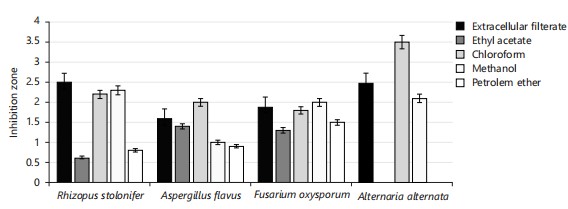
|
| Table 1: | Screening Anabaena sphaerica extracts phytochemically with various solvents | |||
| Extracts | |||||
| Parameter | Methanol | Petroleum ether | Ethanol 70% | Acetone | Dist. Water |
| Phenols | - | - | - | - | - |
| Flavonoids | - | - | * | - | - |
| Alkaloid | * | - | * | * | * |
| Terpenoids | * | - | * | * | * |
| Saponin | * | - | * | * | * |
| Glycosides | - | - | - | - | * |
| Amino acids | - | - | * | - | * |
| Carbohydrates | * | - | * | * | * |
| Diterpenes | - | - | - | - | * |
| *Presence and -: Absence | |||||
Cyanobacteria are receiving a lot of attention because of their suitability across several industrial sectors and their abundance of secondary metabolites. Some of these compounds are well-known for their remarkable capacity to prevent the growth of fungi. These metabolites exhibit a great deal of biological and chemical diversity7,17,19-21.
The antifungal activity of extracts from Anabaena sphaerica against four specific plant pathogenic fungi (Fusarium oxysporum, Alternaria alternata, Aspergillus flavus, and Rhizopus stolonifer) at a concentration of 1 mg of extract/disc is displayed in Fig. 2-6, respectively. According to the study, the type of extract and solvent employed in the extraction procedure, as well as the fungal organisms that were examined, are the main influences of the inhibitory zone’s diameter. In comparison to organic extracts of the cyanobacterium cell pellet extract, the wasted media extract proved to be the most effective, according to the study’s results. In general, Fig. 3 indicates that the cyanobacteria Anabaena sphaerica under investigation exhibited a high level of fungicide potential based on the measured inhibitory zone widths (Fig. 2). In terms of extracellular metabolites, Fig. 2 demonstrated that Aspergillus flavus had the smallest inhibitory zones (1.6 cm), while Alternaria alternata and Rhizopus stolonifer had the greatest (2.5 cm). According to Table 1, choloform was the most effective solvent for the extraction of endogenous metabolites from intracellular metabolites extracted from the cyanobacterium Anabaena sphaerica. Methanol, ethyl acetate, and petroleum ether were the next best solvents. In terms of extracellular metabolites, Aspergillus flavus had the smallest inhibition zones (1.6 cm), while Rhizopus stolonifer and Alternaria alternata had the largest (2.5 cm). Chloroformic extract exhibited a maximum inhibition zone of 3.5 cm against Alternata and a minimum of 1.8 cm against Fusarium oxysporium. Additionally, the methanolic extract of the cyanobacterium cell pellet demonstrated strong inhibition zones of 2.3 cm against Rhizopus stolonifer and 1.0 cm against Aspergillus flavus.
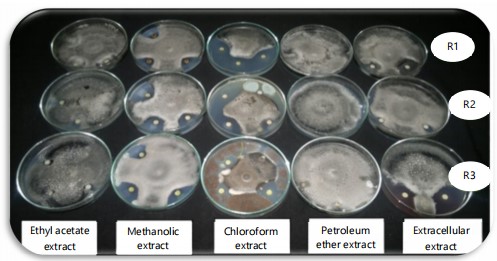
|

|
Conversely, petroleum ether and ethyl acetate extracts showed no inhibitory zone against Alternaria alternata and were the least effective against all tested fungi (Fig. 3). When it came to Aspergillus flavus, the ethyl acetate extract’s maximal inhibitory zone was 1.4 cm (Fig. 4), whereas for Rhizopus stolonifera, it was at least 0.6 cm (Fig. 6). Regarding extracellular metabolites, Rhizopus stolonifer had the largest inhibition zone (Fig. 6). Figure 5 showed that the chloroformic extract exhibited a maximum inhibition zone against Fusarium oxysporium. According to the findings of this investigation, the best solvent for extracting endogenous metabolites from intracellular metabolites retrieved from the cyanobacterium Anabaena sphaerica was chloroform, which was followed by methanol, ethyl acetate, and petroleum ether. Given that it had the lowest inhibitory zones, the data collected indicated that the pathogenic fungus Aspergillus flavus under investigation was the one that was less vulnerable to the cyanobacterium Anabaena sphaerica extracts (Fig. 4). Overall, these findings showed that the solvent type and the tested pathogen all had a significant impact on the extracts antifungal effectiveness.
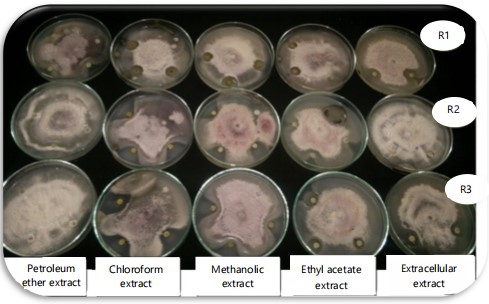
|
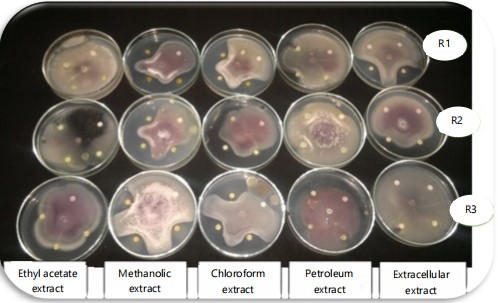
|
Cyanobacteria are known to live in a variety of environments and, in response to changing growth conditions, generate a variety of primary and secondary metabolites that they can adapt to and use as a defence mechanism to help them survive17,20,26. Antimicrobial activity was supported by a number of metabolites, including pigments, carbohydrates, polyphenols, fatty acids, lipids, hydrocarbons, and other cellular compounds17,27,28. There are reports of cyanobacteria preventing the growth of plant-pathogenic fungi. The antifungal activity of cyanobacterial strains Oscillatoria, Anabaena, Nostoc, Nodularia, and Calothrix against seven phytopathogenic fungi that cause illnesses in hot peppers was documented by Kim29. On the other hand, the presence of bioactive substances may be facilitated by the antifungal activity of algal culture filtrates and extracts of algal cell pellets, according to Al-Sheikh19, These reports are in agreement with our present study.
CONCLUSION
The present study highlights Anabaena sphaerica as a promising source of bioactive compounds with significant antifungal activity. Its extracts demonstrated strong inhibition against phytopathogenic fungi, suggesting its potential as a natural biocontrol agent. Additionally, cyanobacteria like A. sphaerica may contribute to soil fertility and plant growth promotion. Further research is warranted to explore and isolate specific antifungal compounds from this strain for potential agricultural and pharmaceutical applications.
SIGNIFICANCE STATEMENT
In sustainable agriculture, cyanobacteria are a useful source of natural antifungal agents. These microorganisms synthesize a range of bioactive substances with antifungal characteristics, such as peptides and other secondary metabolites. The current investigation demonstrated that the cyanobacterium Anabaena sphaerica is a potential donor of bioactive compounds with antifungal activities. This research contributes to environmental sustainability, which can aid in the management of plant diseases and lessen the need for artificial fungicides.
REFERENCES
- Grabowski, Ł., K. Wiśniewska, M. Żabińska, M. Konarzewska and M. Zielenkiewicz et al., 2024. Cyanobacteria and their metabolites-can they be helpful in the fight against pathogenic microbes? Blue Biotechnol., 1.
- Mazard, S., A. Penesyan, M. Ostrowski, I.T. Paulsen and S. Egan, 2016. Tiny microbes with a big impact: The role of cyanobacteria and their metabolites in shaping our future. Mar. Drugs, 14.
- Carpine, R., G. Olivieri, K.J. Hellingwerf, A. Pollio and A. Marzocchella, 2020. Industrial production of poly-β-hydroxybutyrate from CO2: Can cyanobacteria meet this challenge? Processes, 8.
- Sheikh, H., A. El-Naggar and D. Al-Sobahi, 2018. Evaluation of antimycotic activity of extracts of marine algae collected from Red Sea Coast, Jeddah, Saudi Arabia. J. Biosci. Med., 6: 51-68.
- Besednova, N.N., B.G. Andryukov, T.S. Zaporozhets, S.P. Kryzhanovsky and T.A. Kuznetsova et al., 2020. Algae polyphenolic compounds and modern antibacterial strategies: Current achievements and immediate prospects. Biomedicines, 8.
- Silva, A., S.A. Silva, M. Carpena, P. Garcia-Oliveira and P. Gullón et al., 2020. Macroalgae as a source of valuable antimicrobial compounds: Extraction and applications. Antibiotics, 9.
- Pointcheval, M., A. Massé, D. Floc’hlay, F. Chanonat, J. Estival and M.J. Durand, 2025. Antimicrobial properties of selected microalgae exopolysaccharide-enriched extracts: Influence of antimicrobial assays and targeted microorganisms. Front. Microbiol., 16.
- Abd El Sadek, D.A., R.A. Hamouda, K. Bassiouny and H. El Haroun, 2017. In vitro antioxidant and anticancer activity of cyanobacteria. Asian J. Health Med., 6.
- Kar, J., D.P. Ramrao, R. Zomuansangi, C. Lalbiaktluangi and S.M. Singh et al., 2022. Revisiting the role of cyanobacteria-derived metabolites as antimicrobial agent: A 21st century perspective. Front. Microbiol., 13.
- Pandey, V.D., 2015. Cyanobacterial natural products as antimicrobial agents. Int. J. Curr. Microbiol. Appl. Sci., 4: 310-317.
- Allen, M.M., 1968. Simple conditions for growth of unicellular blue-green algae on plates. J. Phycol., 4: 1-4.
- Desikachary, T.V., 1959. Cyanophyta. Indian Council of Agricultural Research, New Delhi, India, Pages: 686.
- Mudimu, O., N. Rybalka, T. Bauersachs, J. Born, T. Friedl and R. Schulz, 2014. Biotechnological screening of microalgal and cyanobacterial strains for biogas production and antibacterial and antifungal effects. Metabolites, 4: 373-393.
- Princely, S. and M.D. Dhanaraju, 2017. Assessment of phytochemical constituents, in vitro antimicrobial and antioxidant potential of Ulva extracts from Vishakhapatnam Coast. Asian J. Pharm. Clin. Res., 10: 87-95.
- Ghasemi, Y., M.T. Yazdi, A. Shafiee, M. Amini, S. Shokravi and G. Zarrini, 2004. Parsiguine, a novel antimicrobial substance from Fischerella ambigua. Pharm. Biol., 42: 318-322.
- Savithramma, N., M.L. Rao, K. Rukmini and P.S. Devi, 2011. Antimicrobial activity of silver nanoparticles synthesized by using medicinal plants. Int. J. ChemTech Res., 3: 1394-1402.
- Gheda, S.F. and G.A. Ismail, 2020. Natural products from some soil cyanobacterial extracts with potent antimicrobial, antioxidant and cytotoxic activities. Anais Acad. Bras. Ciênc., 92.
- Singh, R.K., S.P. Tiwari, A.K. Rai and T.M. Mohapatra, 2011. Cyanobacteria: An emerging source for drug discovery. J. Antibiot., 64: 401-412.
- Al-Sheikh, H.M., 2014. Antifungal activity of the cyanobacterium Nostoc muscorum isolated from Al-Hassa, Saudi Arabia. J. Pure Appl. Microbiol., 9: 111-117.
- do Amaral, S.C., L.P. Xavier, V. Vasconcelos and A.V. Santos, 2023. Cyanobacteria: A promising source of antifungal metabolites. Mar. Drugs, 21.
- Abu Ahmed, S.E.S., M.A. Deyab, F.S. El-Ashry and M.F. El-Adl, 2021. Qualitative and quantitative phytochemical composition of Sargassum vulgare at Hurghada Red Sea Coast-Egypt. Sci. J. Damietta Fac. Sci., 11: 10-19.
- Kuda, T., M. Tsunekawa, H. Goto and Y. Araki, 2005. Antioxidant properties of four edible algae harvested in the Noto Peninsula, Japan. J. Food Compos. Anal., 18: 625-633.
- Parveen, M., R.M. Ghalib, Z. Khanam, S.H. Mehdi and M. Ali, 2010. A novel antimicrobial agent from the leaves of Peltophorum vogelianum (Benth.). Nat. Prod. Res., 24: 1268-1273.
- Bellahcen, T.O., A.A. Amiri, I. Touam, F. Hmimid, A. El Amrani, A. Cherif and M. Cherki, 2020. Evaluation of Moroccan microalgae: Spirulina platensis as a potential source of natural antioxidants. J. Complementary Integr. Med., 17.
- Abd El-Karim, M.S., 2016. Chemical composition and antimicrobial activities of cyanobacterial mats from hyper saline lakes, northern western desert, Egypt. J. Appl. Sci., 16: 1-10.
- Allaf, M.M. and H. Peerhossaini, 2022. Cyanobacteria: Model microorganisms and beyond. Microorganisms, 10.
- Pradhan, J., S. Das and B.K. Das, 2014. Antibacterial activity of freshwater microalgae: A review. Afr. J. Pharm. Pharmacol., 8: 809-818.
- Ilieva, Y., M.M. Zaharieva, H. Najdenski and A.D. Kroumov, 2024. Antimicrobial activity of Arthrospira (former Spirulina) and Dunaliella related to recognized antimicrobial bioactive compounds. Int. J. Mol. Sci., 25.
- Kim, J.D., 2006. Screening of cyanobacteria (blue-green algae) from rice paddy soil for antifungal activity against plant pathogenic fungi. Mycobiology, 34: 138-142.
How to Cite this paper?
APA-7 Style
Elaziz,
B.A., Fathi,
A., Saber,
H., Shoulkamy,
M. (2025). Antifungal Potential of Cyanobacterium Anabaena sphaerica as a Biocontrol Agent Against Phytopathogenic Fungi. Trends in Environmental Sciences, 1(3), 280-287. https://doi.org/10.21124/tes.2025.280.287
ACS Style
Elaziz,
B.A.; Fathi,
A.; Saber,
H.; Shoulkamy,
M. Antifungal Potential of Cyanobacterium Anabaena sphaerica as a Biocontrol Agent Against Phytopathogenic Fungi. Trends Env. Sci 2025, 1, 280-287. https://doi.org/10.21124/tes.2025.280.287
AMA Style
Elaziz
BA, Fathi
A, Saber
H, Shoulkamy
M. Antifungal Potential of Cyanobacterium Anabaena sphaerica as a Biocontrol Agent Against Phytopathogenic Fungi. Trends in Environmental Sciences. 2025; 1(3): 280-287. https://doi.org/10.21124/tes.2025.280.287
Chicago/Turabian Style
Elaziz, B.E., Abd, A.A. Fathi, H. Saber, and M.A. Shoulkamy.
2025. "Antifungal Potential of Cyanobacterium Anabaena sphaerica as a Biocontrol Agent Against Phytopathogenic Fungi" Trends in Environmental Sciences 1, no. 3: 280-287. https://doi.org/10.21124/tes.2025.280.287

This work is licensed under a Creative Commons Attribution 4.0 International License.
